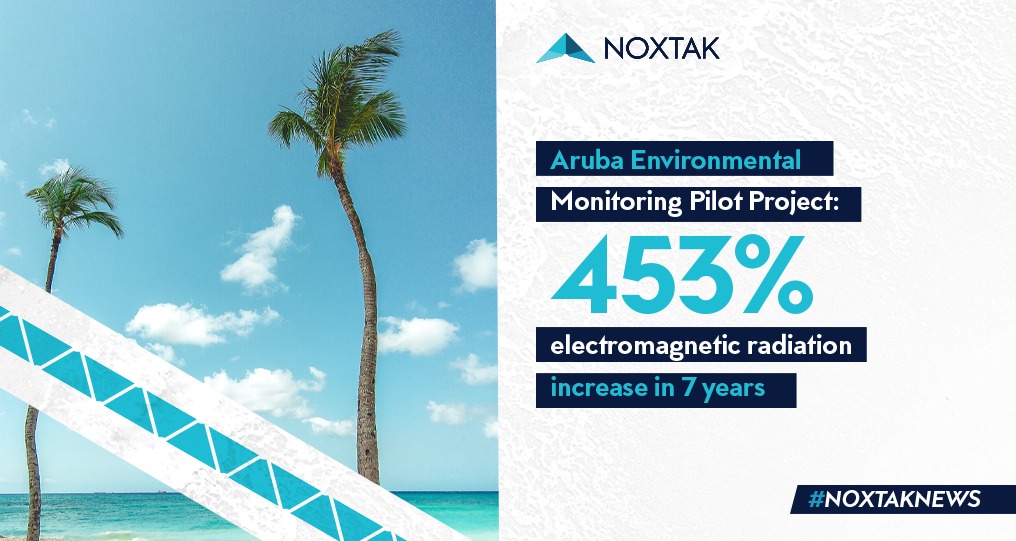In 2013, with the Central Bureau of Statistics of Aruba’s authorization and endorsement, NOXTAK’s research team deployed its pilot environmental monitoring project on the island. This project was a portal to broader knowledge that today has served us to continue developing solutions.

NOXTAK was founded as a scientific project on Aruba island in 2012, impulsed by an initiative that started by investigating environmental emissions and their progressive increase in daily life and industries, near-field emissions, and far-field emissions, also known as background levels of radiation. But, ultimately, NOXTAK’s approach was focused on the search to develop a technology that would allow the daily use of technologies without representing any risk to health and the environment.
Aruba functioned as a living laboratory for all the investigations the team had in mind because the island contained all the environmental conditions typically found in different urban contexts. All we needed for an extensive study of electromagnetic pollution. This is how this island became the headquarters of this environmental scientific research pilot project, complemented by exploratory studies on its neighboring island Curacao.
This project was developed from January 2013 to January 2020. It was meant to monitor electrosmog emissions on the island to verify the increase or variations in radio frequency and microwave exposure, known as background emissions.
About the Pilot Project
The pilot project started on January 15, 2013. The first reference frame or base measurement was established defining the areas to be monitored and the different variables implicit in each of the eight regions defined by the Central Bureau of Statistics of Aruba. Since then, these values were observed, paying particular attention to the update periods of the telecommunications platform on the island, from the change from 2G to 3G, then the update to 4G LTE, as well as observing the incidence in the increase in emissions in WiFi public areas.
We did exploratory research using GPS to have specific geolocated locations from where the measurements were being taken. We also used specialized radio frequency meters and low-frequency magnetic flow meters to monitor magnetic fields coming from electrical problems.
What did we assess?
For seven years straight, we evaluated the exposure levels in shops, industries, offices, residential areas, tourist areas, areas near mobile phone base stations, the Reina Beatrix airport, etc. We traveled more than 150 km2 of the island to monitor the increase in electromagnetic emissions by implementing new technologies, the growth in some residential and commercial areas, and more.
Over the years, the NOXTAK research team was able to identify the areas of high electromagnetic pollution due to extremely low frequencies associated with current fields in regions where the grounding was not adequate, or the urban planning was deficient. We were also able to make dirty electricity measurements in the power systems of residential, commercial, and touristic areas.
On the island, we had the opportunity to assess an airport’s exposure with a significant tourist movement. This gave us a better understanding of the typical exposure conditions found in a small airport like this one and the urban context surrounding it, which is also affected somehow. Additionally, we seized the opportunity to measure docks and surrounding areas when cruises or military ships arrived.
We had a particular focus on touristic areas, where we monitored the WiFi exposure levels, the increase of 2.4 GHz signals, and how these signals impact public exposure levels. Lastly, we could also observe the artificial electromagnetic trails left by tourists’ passage in natural areas through a particular measurement in the Arikok National Park.
The findings of our investigation
Up to 2020, the pilot project collected enough data that has given us insights to make special considerations on the incidence of Electromagnetic Radiation in environments such as urban, rural, and natural reserves. We also got the knowledge to determine the electromagnetic footprint of renewable energies, such as wind and solar parks.
The main objective of the research project was to monitor and determine the progressive increase in background emissions. Simultaneously, this project brought us an extra complementary knowledge about electromagnetic radiation, specifically about the exposure conditions of people, the different factors and variables of each area, and also allowed us to identify an increase in pollution due to the rise in mobile telephony users, data traffic, and technology users. We concluded that these increases were not only due to the change in a technological or telecom generation, it was for the massive demand for data and technology too.
We could see a change in the middle of the transition from 3G to 4G and increases of 300% in radiation levels could also be noted from 2013 to 2017, and from 2017 to 2020, there was another significant increase of 153%; that is a total increase of 453% in 7 years. But, as we mentioned before, we have to keep in mind that generation changes are gradual and do not happen overnight, just like 5G technology. The same has happened with previous generations, which refutes many of the comments that attribute the increase in background exposure levels to the change in telecommunications generation.
Lastly, we had an interesting finding around the changes in electromagnetic exposure in this tropical island with ships’ arrival. We had the opportunity to verify background exposure levels with and without the presence of cruise ships. We found higher concentrations of radiation when they were present, and those levels decreased when they left. The same happened with the passage of military vessels.
This project has 7 years of invaluable knowledge that can significantly help local governments and officers in charge of urban planning and environmental matters. But most importantly, this pilot was an unlimited source of knowledge for our research team, which got the opportunity to learn and understand real urban problems that will help them develop real solutions for the future.
Do you want to get more information of interest like this? Stay tuned for more articles by subscribing to our blog in the form at the bottom of this page.
